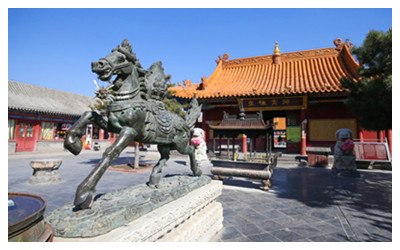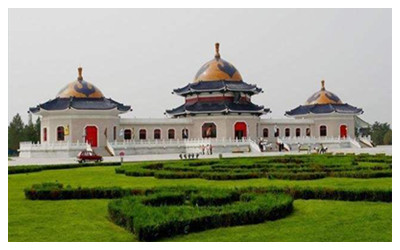Skype: neodalle-travel
Tel: +86 135 7447 2266
E-mail: sales@visitaroundchina.com
 As early as the Old Stone Age, humans had inhabited the area of present-day Inner Mongolia. A number of historical sources has borne out this claim. For example, excavations at the site of Dayao show that the area was an ancient stone-producing site for early humans. A large quantity of stone artifacts were unearthed in this area, such as hammers as well as chopping and cutting tools. The archeological site of Dayao provides strong evidence that suggests that Inner Mongolia was a cradle of ancient Chinese civilization*, namely, via the Hongshan Culture, which is centered around the city of Chifeng and south of the city of Tongliao. These two cities lie in the Xilamulun River area and the Laoha River area, respectively. Hongshan Culture is famous for its painted potteries. The large number of artifacts - and their high degree of sophistication - discovered in the Hongshan area has provided a good basis for continued archeological and anthropological research.
As early as the Old Stone Age, humans had inhabited the area of present-day Inner Mongolia. A number of historical sources has borne out this claim. For example, excavations at the site of Dayao show that the area was an ancient stone-producing site for early humans. A large quantity of stone artifacts were unearthed in this area, such as hammers as well as chopping and cutting tools. The archeological site of Dayao provides strong evidence that suggests that Inner Mongolia was a cradle of ancient Chinese civilization*, namely, via the Hongshan Culture, which is centered around the city of Chifeng and south of the city of Tongliao. These two cities lie in the Xilamulun River area and the Laoha River area, respectively. Hongshan Culture is famous for its painted potteries. The large number of artifacts - and their high degree of sophistication - discovered in the Hongshan area has provided a good basis for continued archeological and anthropological research.
 It was first during the Song (CE 960-1279) Dynasty that a large Mongol tribe appeared in the area. Earlier, i.e., from the Tang (CE 618-907) Dynasty down to the arrival of Genghis Khan (see a short profile of Genghis Khan below) and his Mongol hordes, the territory called Inner Mongolia was inhabited primarily by Turkic tribes. With the rise of the Yuan (CE 1279-1368) Dynasty, the area came under strong central government rule, which in fact was Mongolian rule (the first emperor of the Yuan Dynasty, it will be remembered, was Kublia Khan, the grandson of Genghis Khan), and the numbers of Mongols in present-day Inner Mongolia increased.
It was first during the Song (CE 960-1279) Dynasty that a large Mongol tribe appeared in the area. Earlier, i.e., from the Tang (CE 618-907) Dynasty down to the arrival of Genghis Khan (see a short profile of Genghis Khan below) and his Mongol hordes, the territory called Inner Mongolia was inhabited primarily by Turkic tribes. With the rise of the Yuan (CE 1279-1368) Dynasty, the area came under strong central government rule, which in fact was Mongolian rule (the first emperor of the Yuan Dynasty, it will be remembered, was Kublia Khan, the grandson of Genghis Khan), and the numbers of Mongols in present-day Inner Mongolia increased.
Under the Han Chinese Ming (CE 1368-1644) Dynasty, which had overthrown the Mongol Chinese Yuan Dynasty, Inner Mongolia itself was divided into two separate adminsitrative regions, Dada and Wala. "Northern" and "southern" Mongolia, corresponding to present-day Outer and Inner Mongolia, respectively, were always somewhat divided, as the Monan designation indicates, due to the presence the Gobi Desert, a natural barrier which roughly divides the two areas (it overlaps both areas), thus weakening any bond which might exist even on an ethnic basis. During the Manchu Qing Dynasty, Inner Mongolia was re-unified (the Dada and Wala administrative regions were disbanded), though the areas corresponding to present-day Inner and Outer Mongolia remained separate - both administratively and to some extent culturally - with Inner Mongolia becoming more etnically mixed than Outer Mongolia.
This tendency would only increase, such that when the Qing Dynasty fell - leaving the newly-formed Republic of China, on the one hand, and Mongolia on the other hand, to emerge from the ashes of Imperial China - the Republic of China would have its own reasons to retain that portion of Mongolia with which it had closest ties, namely, "southern" Mongolia, which, at the time, was under the administration of three separate provinces: Rehe, Chahaer, and Suiyuan (the name "Inner Mongolia" had not yet been conceived).
When the Republic of China gave way to the People's Republic of China, the territory corresponding to "southern" Mongolia had become such an integral part of China that it was unthinkable to relinquish it, though, in response to the territory's primary ethnic minority make-up (the Han Chinese were already the ethnic majority), it was designated as Inner Mongolia and was soon thereafter - on May 1st, 1947 - made into an autonomous region, the first such ethnic region within the PRC.
 Ask Questions ?
Ask Questions ?